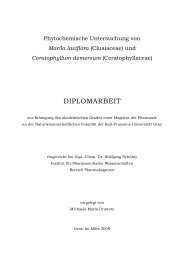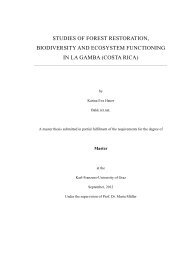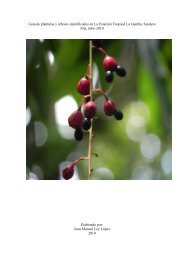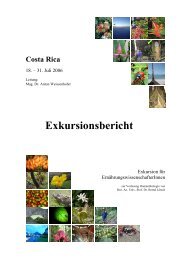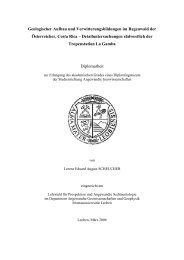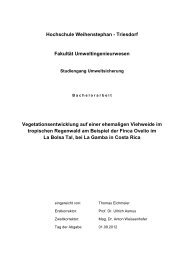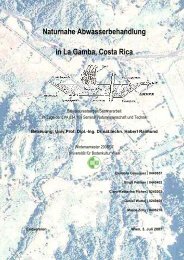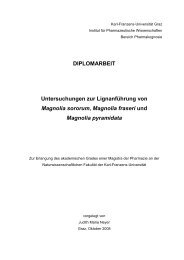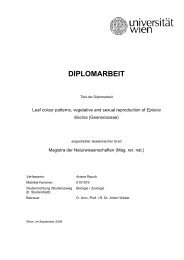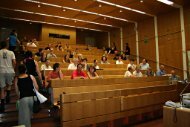Die Tropenstation La Gamba
Die Tropenstation La Gamba
Die Tropenstation La Gamba
Erfolgreiche ePaper selbst erstellen
Machen Sie aus Ihren PDF Publikationen ein blätterbares Flipbook mit unserer einzigartigen Google optimierten e-Paper Software.
<strong>Die</strong> „<strong>Tropenstation</strong> <strong>La</strong> <strong>Gamba</strong>“ in Costa Rica – Wissenschaftlicher Bericht<br />
LAUTSCH, D. 2000: Ferns and fern allies of the Bosque Esquinas ("Regenwald der<br />
Österreicher"), Costa Rica. - Diploma Thesis, University of Vienna. Vienna. Faculty for<br />
mathematical and natural science.<br />
The study deals with the diversity and (to a minor degree) ecology of ferns and fern<br />
allies in the Bosque Esquinas, Costa Rica. The Bosque Esquinas ("Regenwald der<br />
Österreicher") is situated in SE Costa Rica at 8'41' N and 83'13' W, between the Golfo<br />
Dulce (Pacific Ocean) and the Carretera Interamericana. The forest covers an area of<br />
approx. 14 000 ha (140 km') and is part of the Corcovado National Park. According to<br />
HOLDRIDGE's Life Zone System (HOLDRIDGE, 1967) the Esquinas forest can be<br />
classified as a 'Tropical Wet Forest', annual rainfall is around 6500-7000 mm and<br />
average temperature c. 27.5'C.<br />
Collection work and field studies were carried out during a period of five<br />
months (Feb. to April, and July to September 1999). The Biological Station <strong>La</strong> <strong>Gamba</strong><br />
served as base for the field work. The floristic inventory is certainly not complete, but is<br />
thought to cover the most significant and most frequent taxa.<br />
Specimens of 83 species out of 47 genera of Pteridophyta s. str. were collected<br />
and identified to species. The total number of species to be expected in the Esquinas<br />
forest is perhaps 100-120 species in around 50 genera. The group of Lyopodiophyta,<br />
especially the genus Selaginella, needs further study and is treated here only<br />
fragmentarily. In this group c. 15 species in three genera can be expected. Keys are<br />
presented for identification of the ferns recorded and descriptions of the families, genera<br />
and species are provided together with illustrations of most species.<br />
The forest sites with the highest fern density, both in species and individual<br />
number, were found to be the ravines. This is apparently a result of general adaptation of<br />
ferns to wet and instable environments. Most of the species occurring in primary forest<br />
are not restricted to it, whereas most of the species characteristic of disturbed sites and<br />
secondary forest are not found in primary forest. The latter ferns are very important<br />
plants in vegetation succession.<br />
With regard vascular plants, the most significant pioneers in vegetation<br />
succession are the following ferns: Pityrogramma calomelanos (Pteridaceae),<br />
Dicranopteris pectinata (Gleicheniaceae) and Lycopodiella cernua<br />
(Lycopodiaceae/Lycopodiophyta). In the subsequent step of succession, species of<br />
Cyatheaceae become (among others) important. Cnemidaria choricarpa (Cyatheaceae)<br />
invades wet, Metaxya rostrata (Metaxyaceae) dry sites. In secondary forest Cyathea spp.<br />
are important treelets.<br />
There are two key species indicating dry soil: Polybotria cervina<br />
(Dryopteridaceae) and Lygodium venustum (Schizaeaceae). Five species can be taken as<br />
indicative of wet soil: Nephrolepis multflora (Oleandraceae), Lonchitis hirsuta<br />
(Dennstaedtiaceae), Thelypteris nicaraguensis (Thelypteridaceae), Tectaria<br />
draconoptera, T plantaginea and T. incisa (Tectariaceae). Acrostichum aureum<br />
(Pteridaceae) is the key species indicating saline soil. In the brackish 'slacks' at the Golfo<br />
Dulce a characteristic association of Acrostichum aureum (Pteridaceae) and Nephrolepis<br />
multiflora (Oleandraceae) and Cocos nucifera (Arecaceae) can be found.<br />
Anschrift des Autors:<br />
Mag. Dominik <strong>La</strong>utsch<br />
Inst. f. Botanik der Univ. Wien<br />
Rennweg 14, A-1030 Wien<br />
TEL. ++43-1-4277-54080<br />
Fax. ++43-1-4277-9541<br />
a9606933@unet.univie.ac.at<br />
79



